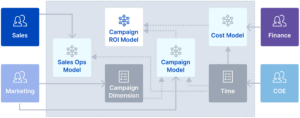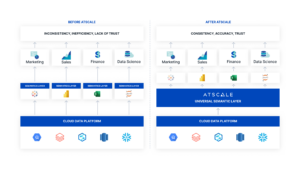April 13, 2023
Actionable Data Insights for Improved Business ResultsIn today’s fast-paced business environment, data is a crucial asset. Data teams must be modernized with advanced frameworks and technologies to leverage this data effectively. One such approach is integrating a semantic layer and employing a Hub and Spoke model. This blog delves into the evolving structure of modern data teams, the critical roles within these teams, and how the semantic layer and Hub and Spoke model can enhance their performance and collaboration.
The Modern Data Team
Data teams have evolved significantly over the past few decades. Initially, data management was relegated to IT departments, focusing on data storage and basic reporting as data became more integral to business decision-making, the roles within data teams diversified and specialized.
In the past, data teams were typically composed of database administrators and IT professionals. Their primary responsibilities included maintaining databases, ensuring data integrity, and generating basic reports. However, the explosion of big data, advancements in analytics, and the rise of data-driven decision-making necessitated the creation of more specialized roles, such as data engineers, data analysts, and data scientists. These roles have distinct responsibilities but must work in unison to drive insights and add value to the organization.
Role of Data Engineer
Data engineers are the backbone of modern data teams. They design, build, and maintain the infrastructure that allows data to flow seamlessly within an organization. This involves creating pipelines that collect, process, and store data from various sources. They ensure that data is accessible, reliable, and well-structured for analysis.
Key responsibilities include:
- Building and Maintaining Data Pipelines: Ensuring that data from various sources is collected, cleaned, and stored in a usable format.
- Data Warehousing: Designing and managing data warehouses where structured data can be stored and easily accessed.
- Data Integration: Combining data from different sources to provide a unified view.
- Optimizing Data Storage: Implementing efficient data storage and retrieval strategies, ensuring scalability and performance.
Role of Data Analyst
Data analysts interpret data and transform it into actionable insights. They analyze data sets to identify trends, patterns, and anomalies that can inform business decisions. Data analysts often work closely with business stakeholders to understand their needs and provide data-driven recommendations.
Key responsibilities include:
- Data Exploration and Analysis: Investigating data to discover patterns and trends.
- Reporting and Visualization: Creating dashboards and reports to communicate findings to stakeholders.
- Ad Hoc Analysis: Performing specific analyses as requested by different departments.
- Data Cleaning: Ensuring data quality by identifying and rectifying inconsistencies.
Role of Data Scientist
Data scientists take data analysis a step further by applying advanced statistical, machine learning, and predictive modeling techniques to extract deeper insights from data. Their work often involves developing algorithms and models to predict future trends or outcomes.
Key responsibilities include:
- Building Predictive Models: Using statistical and machine learning techniques to forecast future trends.
- Experimentation: Designing and conducting experiments to test hypotheses and validate models.
- Advanced Analytics: Performing complex analyses that go beyond standard reporting.
- Collaboration with Engineering Teams: Working with data engineers to ensure the models can be integrated into production systems.
How Does a Semantic Layer Impact the Team?
A semantic layer acts as an intermediary between raw data and end users, providing a unified, business-friendly view of data. This abstraction layer simplifies data access and interpretation, allowing users to query data without understanding its complexity. The impact on data teams includes:
- Improved Accessibility: Data analysts and scientists can access and manipulate data more easily without requiring deep technical knowledge of its structure.
- Consistency: Ensures everyone uses the same definitions and metrics, reducing discrepancies and enhancing data integrity.
- Efficiency: Reduces the time spent on data preparation and transformation, allowing data professionals to focus on analysis and innovation.
- Performance: Improves the performance of live queries without creating data imports or data extracts for each BI tool.
For data engineers, a semantic layer simplifies data integration and reduces the complexity of data pipelines. It abstracts the underlying complexities and presents a consistent data model, making maintaining data integrity and consistency easier.
For data analysts, the semantic layer provides a more intuitive interface for working with data. They can access and analyze data without understanding the underlying database schemas or writing complex SQL queries. This accelerates the analysis process and empowers analysts to focus on generating insights.
For data scientists, the semantic layer ensures they can access clean, well-structured data, which is crucial for building accurate models. It also allows them to experiment and iterate faster by providing a consistent data view.
The semantic layer empowers data teams to work more efficiently and effectively, promoting a culture of self-service analytics.
Hub and Spoke Model + Modern Data Team
The Hub and Spoke model is a strategic approach to data management that centralizes core data functions (the hub) while distributing specific analytical tasks to different business units (the spokes). This model promotes collaboration by ensuring that all departments have access to a centralized data repository, reducing data silos, and fostering a culture of data sharing.
In the Hub and Spoke model:
- The Hub: A centralized data team responsible for data governance, infrastructure, overall data strategy, and potentially common semantic objects.
- The Spokes: Distributed data analysts and scientists embedded within various business units, focusing on their specific analytical needs.

This model promotes collaboration and ensures that data initiatives align with business objectives.
- Promoting Collaboration: The hub is the central repository of data expertise and shared semantic objects, fostering communication and knowledge sharing among the spokes. This structure ensures that best practices and standards are maintained across the organization.
- Enhanced Governance: Centralized control in the hub ensures data governance and compliance, while spokes can tailor data solutions to their specific needs.
- Scalability: The model allows for scalable growth, as new spokes can be added without disrupting the overall structure.
How Does a Semantic Layer Improve This?
The semantic layer is essential for the Hub and Spoke model as it provides a consistent and accessible view of data across the organization around a shared, standard set of semantic objects. It ensures that all spokes have access to the same, consistent data definitions and metrics, reducing the risk of discrepancies and misunderstandings. This consistency fosters better collaboration and more accurate, reliable insights. Shared semantic objects also hide the complexity of their implementations, making it easier for distributed teams to “plug and play” without needing to understand another business team’s logic.
A semantic layer enhances collaboration by:
- Unified Data View: All spokes access the same semantic layer, ensuring data is interpreted consistently across the organization.
- Self-Service Analytics: Empowers spokes to perform their analysis without relying heavily on the central hub, promoting agility and responsiveness.
- Reduced Bottlenecks: By simplifying data access and preparation, the semantic layer reduces bottlenecks in data workflows, enabling faster decision-making.
How the AtScale Semantic Layer is Different

There are a few semantic layer options out there. Still, for the semantic layer to work properly, it needs to modernize legacy OLAP, optimize analytics for cost and performance, break down data silos, and support self-service with governed metrics. It must also support most BI and data science tools and enable decentralized creation and management of data products built on centrally governed, composable analytics objects. Here are some of the key features of the AtScale Semantic Layer and how they benefit modern data teams and organizations:
- Semantic Modeling Language (SML) is an object-oriented, semantic modeling language that supports sharing, encapsulation, and inheritance.
- Git repositories are the source of truth for semantic objects, so versioning and deployments conform to an organization’s software development lifecycle (SDLC), including change approvals and dependency resolution.
- AtScale supports cross-repository references and user-defined semantic object organization using customer-defined files and folders to support any organizational style.
- AtScale delivers a combined no-code and code-first set of modeling tools and APIs that allow all personas (data engineers, data analysts, and data scientists) to collaborate according to their needs and preferences.
Modernizing data teams with a semantic layer and the Hub and Spoke model transforms how organizations handle data. A semantic layer improves efficiency and collaboration and ensures that data-driven insights are accurate, consistent, and actionable. This modernization is essential for businesses looking to stay competitive in today’s data-centric world. To learn more about the AtScale Semantic Layer, watch our overview video.
ANALYST REPORT